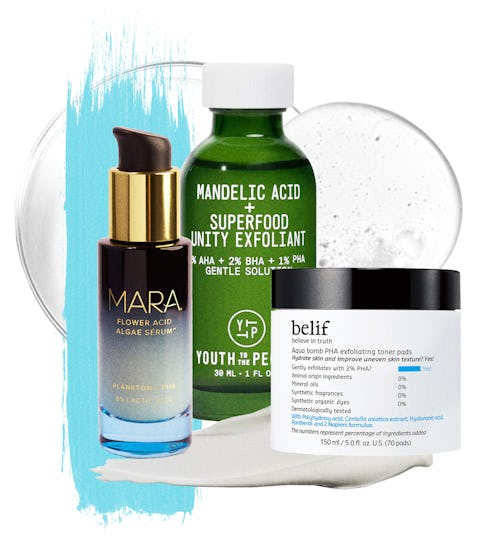(Back To Basics)
This Super Acid Boosts Radiance Without Upsetting Your Skin
No redness, no problem.

With new products, brands, and categories popping up every day, beauty can be a bit overwhelming. Back to Basics is our rudimentary beauty series that serves as your crash course on the science behind some of the best formulations in the game. This week, we’re taking a look at Polyhydroxy Acids for your skin.
On the road to healthy, radiant skin, exfoliation is an important step that should not be missed. By nature, your skin cells turn over every 40 to 56 days, and as they mature, the dead cells need to be removed to reveal the new layers beneath. If you’re a fan of chemical exfoliation, you’ve probably heard of AHAs and BHAs. While these two ingredients are effective in sloughing off old skin, they can be irritating for sensitive complexions. Thankfully, there’s a mild alternative. Enter polyhydroxy acids, a skin care ingredient also known as PHAs.
Often referred to as the cousin of AHAs, this chemical exfoliant has a mild approach that’s less likely to result in redness or irritation. For that reason, it’s quickly popping up in more and more product formulations. Online, a number of #SkinTok creators are paring down the actives in their routines to focus on barrier repair after overdoing it with too many harsh products. Instead, they’re opting for a lighter exfoliant — like a PHA-infused toner — which still improves radiance and tone without the risk of further damage.
Ahead, TZR tapped three dermatologists and a cosmetic chemist to get the rundown on the basics of this buzzy ingredient, including the potential side effects and how to incorporate it into your routine.
What Are Polyhydroxy Acids?
Dr. Lauren Penzi, M.D., board-certified dermatologist at MDCS Dermatology in New York City, tells TZR that polyhydroxy acids are mild chemical exfoliants that work to remove dead skin cells from the surface of the skin with little irritation. Though they provide similar results to common BHA exfoliants like salicylic acid, PHAs are most closely related to AHAs because they are water-soluble and do not penetrate deeply into the skin’s layers. With a larger molecular weight, PHAs work only on the exterior level to exfoliate, smooth, and brighten the skin. This makes them much gentler than other exfoliating acids and a favorable alternative for those with sensitive skin types.
What Are The Skin Care Benefits Of Polyhydroxy Acids?
According to Dr. Penzi, there are three main types of PHAs commonly used in skin care products: gluconolactone acid, galactosen acid, and lactobionic acid. The ingredients’ primary purpose is exfoliation, but there are several other benefits associated with each type of PHA. Gluconolactone and galactose for example, are naturally found within the body and are essential for cell turnover and collagen production. On the other hand, “Lactobionic acid works similar to lactic acid, acting as a humectant and increasing the moisture content within the skin,” says Dr. Kenneth Mark, M.D., a cosmetic dermatologist in New York City.
With collagen-stimulating and hydrating properties, PHAs are also an excellent ingredient for anti-aging concerns such as fine lines and wrinkles. In addition, one scientific study has shown that some PHAs can protect cells against damaging UV rays and photoaging to ultimately fade dark spots and other areas of discoloration.
Who Should Use Polyhydroxy Acids & What Are The Side Effects?
Given that PHAs are mild, anyone can benefit from including the ingredient in their routine. However, it’s important to remember that they’re still chemical acids and can have residual side effects if used improperly. “Like all exfoliators, PHAs have the potential to cause common issues like redness, irritation, and peeling. But given its mild chemical properties, the risks are significantly reduced when compared to other hydroxy acids,” says Dr. Blair Murphy-Rose, M.D., a board-certified cosmetic and medical dermatologist at the Laser & Skin Surgery Center of New York.
How To Incorporate Polyhydroxy Acids Into Your Skin Care Routine
Cosmetic beauty chemist David Petrillo tells TZR that adding PHAs to your existing routine is pretty straightforward because they don’t increase sun sensitivity like AHAs and BHAs do. “PHA products can be used daily in the morning or the evening,” he says. However, you should still start off slowly and monitor your skin’s response along the way. “Start with a low concentration to see how your skin reacts, and be aware of the number of products in your routine that contain the ingredient. PHAs can be found in a range of different product types and you want to avoid over-exfoliating,” he elaborates.
If your skin is extremely sensitive, Dr. Penzi recommends opting for a cleanser with PHAs that will provide the benefits without having to sit on your skin too long. For oily or dry skin types, she suggests using either a toner or serum containing PHAs for optimal results. “Although PHAs are mild, it’s best to avoid combining them with stronger active ingredients like retinoids or other highly-concentrated chemical exfoliants and to always end your routine with SPF,” she says.